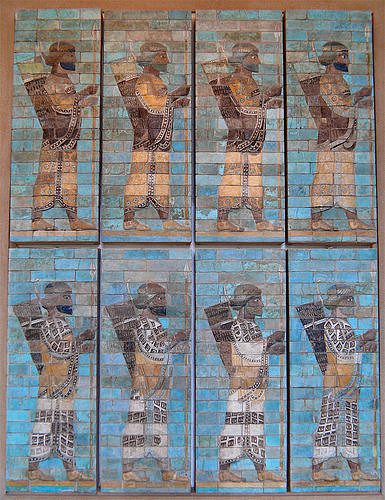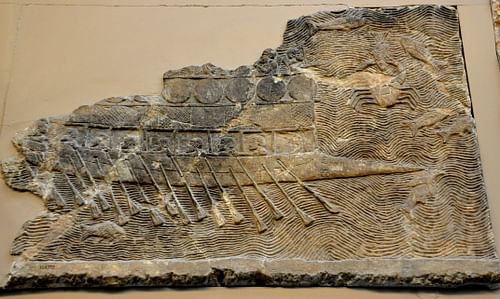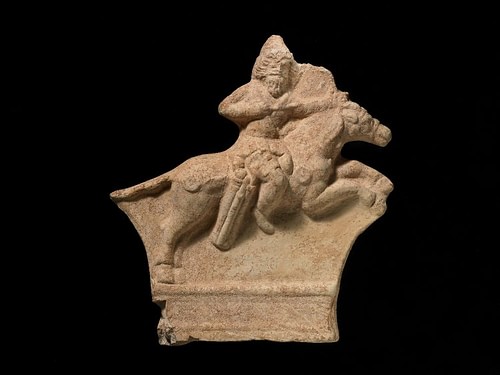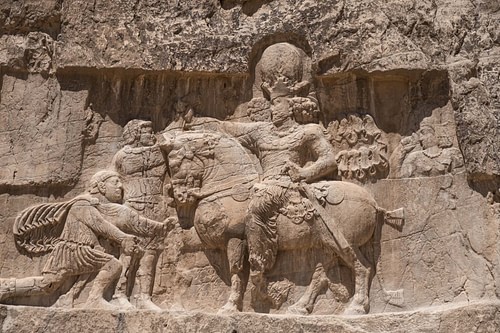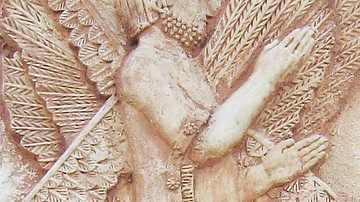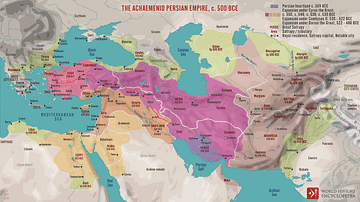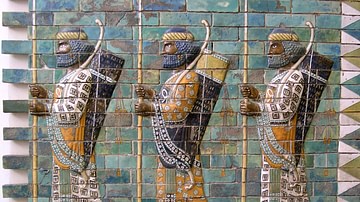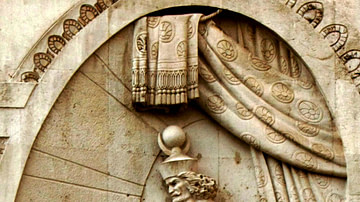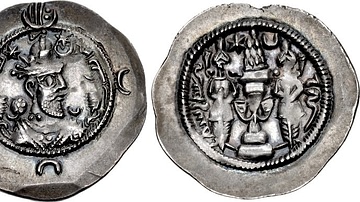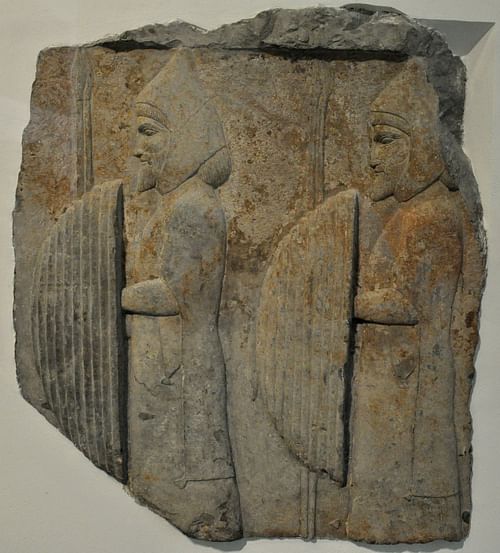
The ancient Persian military evolved from the earlier armed forces of the Medes which, in turn, developed from the warrior class of the indigenous people of the Iranian Plateau, the Aryan migrants (including the Persians) who later settled there, and the Assyrian army which was defeated by the Medes.
The Achaemenid Empire (c. 550-330 BCE) took the best aspects of these earlier models to create one of the most effective military forces in the ancient world. Certain aspects of their model would be changed by the Parthian Empire (247 BCE - 224 CE) and improved upon by the Sassanian Empire (224-651 CE) which skillfully integrated the various aspects of their predecessors in forming a military so effective it was able to withstand repeated invasions by the legions of the Roman Empire. The Sassanian Empire only finally fell when its army was faced with a different, and more effective, military paradigm in the form of the Arab cavalry.
Early Military & Development
Information on the earliest armed forces of the region, those who would have been associated with the ancient civilization of Elam and Susiana, is unavailable. According to scholar A. Sh. Shahbazi of Encyclopedia Iranica:
Source materials for a study of pre-Islamic Iranian military concerns fall into four categories: textual evidence; archeological finds of actual specimens of martial equipments; documentary representations (on monuments and objects of art); and philological deductions for organizational matters. The availability and value of these categories vary according to different periods. (Army, 1)
There must have been some form of military for defense of the cities of the region, however, as the Sumerian King of Lagash, Eannatum (r. c. 2500-2400 BCE) conquered the area and his inscriptions suggest he met resistance in doing so. Sargon of Akkad (r. 2334-2279 BCE) suggests the same in defeating Luh-ishan, son of Hishiprashini, King of Elam c. 2300 BCE.
Whatever weapons, uniforms, and organization characterized these early armies, they were defined by the 1st millennium BCE as comprised of separate citizen units under the command of a tribal chief who could call upon them to fight in times of war. These armies carried a spear, mace, short sword, simple bow and 30 arrows, a dagger, animal-hide or wicker shield, and a poleaxe.
Aryan tribes had migrated to the region at some point prior to the 3rd millennium BCE and, by the 1st millennium BCE, had established themselves in various areas. The Persians settled east of Elam in the territory of Persis and would later expand from there. The Persians, like the Medes and other Aryan tribes (“Aryan” understood as referencing Indo-Iranians), were superb horsemen, and through them, the concept of cavalry was introduced to the region.
The Persians offered their services as mercenaries to the various kings who found them effective in hit-and-run engagements. Cavalry units could strike and retreat quickly, inflicting maximum casualties on the opponent while suffering minimal losses. The use of horses in battle was further enhanced by another innovation also brought to the region by the Aryans: the chariot.
Median Standing Army
In the 8th century BCE, the disparate tribes of the Medes were united under their first king Dayukku (known to the Greeks as Deioces, r. 727-675 BCE). His grandson, Cyaxares (r. 625-585 BCE), expanded Median territory and was instrumental in the fall of the Assyrian Empire. The Assyrians had steadily expanded their empire since the reign of Tiglath Pileser III (745-727 BCE) but had overextended themselves to the point where they had few resources for defense when the Babylonians and Medes led the coalition against them in 612 BCE which would topple their cities.
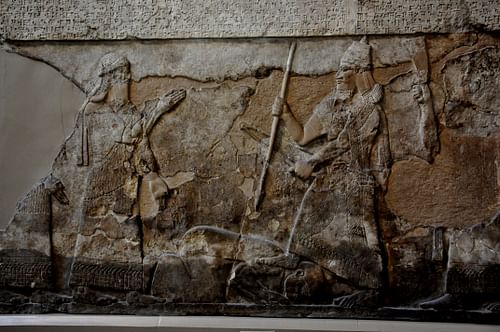
According to Herodotus, Cyaxares was able to accomplish this by reforming the military:
[Cyaxares] was the first to divide his troops into regiments and to make separate units out of the spearmen, archers, and horsemen, who had previously all been jumbled up indiscriminately. (I.103)
The earlier model of drawing up an army was now replaced by the spada – a standing army – which was trained under the direction of the king and led by him. Cyaxares' new army was equipped with spear, bow, short sword, and dagger. The units were separated into infantry, archers, and cavalry; chariots were only used for transportation, not in battle. Cavalry units wore a shirt and trousers under a light leather tunic with a girdle-harness around the waist holding weapons. Their headgear was a cloth tiara possibly worn over a leather helmet. Infantry seem to have worn a similar uniform.
Rise of the Achaemenid Army
C. 550 BCE, Cyrus II (the Great, r. 550-530 BCE) overthrew his grandfather, Astyages of Media (r. 585-550 BCE) and founded the Achaemenid Empire (named in honor of Cyrus' ancestor Achaemenes). Cyrus II defeated the Median army and then conquered Lydia (546 BCE), Elam (540 BCE), and Babylon (539 BCE) with an army raised on the levy system known as the kara. Scholar Stefan G. Chrissanthos explains:
Initially, the Persian army consisted of a militia of the king's Persian subjects. However, not all Persians participated. Only those with sufficient wealth to procure their own military equipment were liable for service; therefore, the levy, or kara, represented the wealthier elements of Persian society. (21)
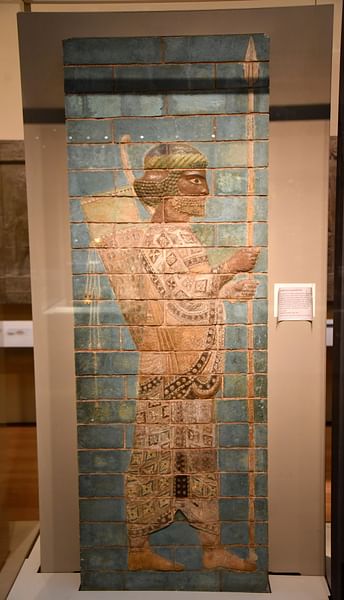
This was not a standing army – like the Assyrians or the Medes had formed – but continued the model of the earlier practice of a chieftain (now the king) calling on those who owed him allegiance to fight. Once Lydia, Elam, and Babylon had been conquered, Cyrus the Great had a great many more resources available to him and, while keeping the kara system, established the standing army of the spada, whose ranks were filled with conscripts from the different satrapies (provinces) of the empire under the command of their satrap (governor). Chrissanthos writes:
As the empire grew, the kara remained the backbone of the army, but now an imperial levy conscripted not only poorer Persians but also subjugated ethnic groups into the army. Herodotus gives a detailed list of the various ethnic contingents that served in the Persian army, and the list includes practically every group in the empire. (21)
The closer a subject people were to the Persians, the less tribute they were required to pay to the king but they were expected to supply more soldiers. The Medes, closely associated with the Persians, were part of the elite units and served as officers – as with the rank of the hazarapatis – a commanding officer of a given unit – along with Persians.
Organization
Organization of the army was based on the decimal system, meaning each unit was comprised of ten lesser units:
- 10 men = a company
- 10 companies = a battalion
- 10 battalions = a division
- 10 divisions = a corps
Each company, battalion, division, and corps had a commanding officer and the whole army was led by a supreme commander, either the king or a noble Persian or Mede who was in the king's trust. The army was divided into infantry (foot-soldiers, archers, slingers) and cavalry and the cavalry further into those who used horses (the asabari – horse-borne) and those who used camels (the usabari – camel-borne). Chariots were also employed in battle but their use depended on the era and ruler. The chariot was commonly used by the supreme commander and the standard-bearers who were responsible for the symbols of the gods Ahura Mazda and Mithra as well as the sacred divine fire which accompanied the troops into battle. The elite of the infantry were the 10,000 troops which made up The Immortals, the king's trusted guard, so-named because, if one fell in battle or could not – for whatever reason – fulfill his duties, another would take his place so their number remained the same, giving the impression they could not be killed.
Different units were identified by different colored uniforms (among the Persians, purple, yellow, and blue). The Immortals wore felt caps (tiaras), brightly-colored, sleeved tunics over shirts and trousers, breast-plate-armor, and carried wicker shields, bows, quivers and arrows, short spears, and daggers (Herodotus 7:61). By the time of Darius I (the Great, r. 522-486 BCE), their spears were longer and ornamented at the bottom by a gold or silver knob.
Training & Battle
Training for the army began at the age of 15 (five for Persian nobility). Youths were divided into 50 classes for military training under an instructor or instructors which included horse grooming and horsemanship, hunting, running, swimming, archery, javelin-throwing, swordsmanship, martial arts, military discipline (such as forced marches, long watches, battle drills, living off the land), and were also expected to contribute to the community by developing agricultural skills. Sons of the king and nobility were also taught to cultivate administrative skills. Military service began at the age of 20 and professional soldiers were allowed to retire at 50; conscripts served for the duration of an engagement or campaign and then, if they survived, could return home until called up again.
Prior to any engagement, a war council was held with the senior staff to solidify the battle plan. Once the enemy was met, archers held the center front of the line with infantry – slingers and foot soldiers – flanking and cavalry on the wings. The archers would begin the battle with support from the slingers hurling small stones and lead pellets and the cavalry would then try to break the enemy lines from either side.
When Darius I invaded Greece in 490 BCE, this was the basic formation which only failed because the Greeks were undeterred by the rain of arrows and, further, had better shields and armor. The Persian army did not pay much attention to body armor or the quality of their shields prior to engagements with the Greeks because, previously, the armies they met had more or less the same equipment and used the same tactics they did. The Macedonian-Greek phalanx, however, was far more effective than the Persian line of formation and the wicker-reed shields of the Persians were no match for the great Greek shields and body armor.
This same basic paradigm held in 480 BCE when Xerxes I (r. 486-465 BCE) invaded Greece in retaliation for Darius I's defeat. The Greeks stopped the Persians at Thermopylae and could have held them there indefinitely if not for their betrayal by one of their own. At Platea, the Persian army was defeated, in part, because of the inferiority of their shields and body armor compared to the Greeks.
Persian Navy
Under Darius I, the Persian navy was expanded. This fleet was not built, nor was it manned, by Persians but by the subject nations of the empire. Cyprus provided 150 ships, Cilicia sent 100 as did Pamphylia, Caria sent 70, and others more or less depending on their resources. The Egyptians and Anatolian Greeks provided a large number but a third of the fleet – at times more but never less – was Phoenician. The Anatolian Greeks, Egyptians, and Phoenicians supplied the great triremes, warships manned by 200 sailors, while other nations shipped and manned smaller vessels, among the most popular being the 50-oar vessel manned by 80 sailors. In battle, in order to prevent defection, 30 Persian Marines were assigned to each ship.
The Persian navy, especially the Phoenician ships, were instrumental in Darius I's campaign to crush the rebellion of the Ionian Greeks which had spread to Cyprus and other regions starting c. 498 BCE. As the revolt was encouraged and funded, in part, by Athens, Darius I launched his massive campaign against Greece in 490 BCE, in which the navy also played a pivotal role but was defeated at the Battle of Marathon. Ten years later, Xerxes I would employ the fleet in his invasion of Greece. The Persian navy was defeated at the Battle of Salamis owing to its reliance on the heavy triremes which were easily outmaneuvered by the smaller and more agile Greek ships.
Parthian Innovations
The Achaemenid Empire fell to Alexander the Great in 330 BCE and, after his death in 323 BCE, was succeeded by the Seleucid Empire (312-63 BCE). The Seleucid Empire was severely compromised following its defeat by the Romans at the Battle of Magnesia in 190 BCE and the resultant Treaty of Apamea in 188 BCE through which they lost most of their territory. The Parthians, who had risen in revolt against the Seleucids in 247 BCE under their king Arsaces I (r. 247-217 BCE), took note of this as well as one of the central reasons for the fall of the Achaemenid Empire to Alexander: unevenly matched weaponry, armor and shields, and tactics. Further, the Parthians realized their own revolt had been able to succeed because the Seleucid military had been unable to respond quickly enough.
The Parthians decentralized the Persian government, instituting a feudal system in which each satrap, who had sworn loyalty to the king, was responsible for a levy of soldiers in times of crisis but no standing army garrisoned, primarily, in a single city (such as at Persepolis under Darius I and Xerxes I) which then had to be mobilized and sent against an enemy. The system of the levy allowed satraps to mobilize an army in their own region and respond directly to a threat, then notify the king of the situation afterwards.
To address the problem of the better body armor and tactics of the Greeks and Romans, the Parthians reduced their reliance on infantry and concentrated their efforts on cavalry. The Parthians, famous for their skills as horsemen, created a powerful force of light and heavy cavalry troops with smaller infantry units for support. The Parthian light cavalry was armed with a bow and arrows, a sword, and probably a dagger and was used in hit-and-run engagements as well as raids and the early stage of battle but they could not contend head-on with heavily armored troops.
In battle, the Parthians relied on their mounted warriors known as cataphracts. These units wore steel helmets and chain mail tunics which went from their necks to past their knees and down the sleeves of the shirt worn under them. They carried composite (compound) bows, which had greater reach and accuracy than the simple longbow, swords, daggers, and a lance. Their horses were equally well-protected with their own chainmail armor.
The most famous battle tactic of Parthian warfare was the Parthian shot in which light cavalry would engage the enemy and then feign retreat, drawing the opponents after them, then turn and fire their arrows back at the enemy, while at full gallop (even more impressive in that they did not have the stirrup). Even after this tactic became known to opposing forces, it still remained effective. Once the enemy was reeling from the shower of arrows, the cataphracts would engage.
The Great Sassanian Army
The Parthian army remained a powerful force but could not finally save the empire from an unexpected threat. The Parthian Empire was not toppled in battle by a superpower like the Roman Empire but by one of its own vassal kings, Ardashir I (r. 224-240 CE), a great warrior who revolted against the Parthian king Artabanus IV (r. 213-224 CE) and founded the Sassanian Empire. Ardashir I was a brilliant general and able statesman and administrator, who learned from the lessons of the past and combined the most effective elements of the Achaemenid, Seleucid, and Parthian empires as well as the tactics of the Romans and the Greeks.
Ardashir I centralized the government and reorganized the military according to the Achaemenid decimal system, bringing it directly under his control. He utilized both the Seleucid and Parthian body armor, kept the Parthian cavalry units, expanded his infantry (again, in line with the Achaemenid system), employed Roman tactics, and also made use of their technology of siege engines and other devices. He also revived the navy, which the Parthians had neglected, although it would play a relatively minor role, after Ardashir I's reign, in battle. Ardashir I's army was so well organized and effective that, under his son, Shapur I (r. 240-270 CE), the Sassanian army not only expanded the empire but defended it against Rome successfully, even capturing the Roman Emperor Valerian (r. 253-260 CE) who was then forced to serve as Shapur I's footstool when he mounted his horse.
Under the later king Kosrau I (also known as Anushirvan the Just, r. 531-579 CE), the Sassanian military was placed under the command of the Minister of Defense who acted in the king's interests. Kosrau I, considered the greatest of the Sassanian kings, continued Ardashir I's basic paradigm for the military and it remained an effective fighting force until the invasion of the Muslim Arabs in the 7th century CE. The Arab armies employed hit-and-run tactics similar to the Parthians, were able to muster larger armies and employ camel-mounted cavalry in greater numbers which performed better than horses on uneven or sandy terrain, and used fast-moving infantry archers, armed with the compound bow, to devastating effect. The Sassanians, last of the ancient Persian empires, fell to the Arabs in 651 CE, and their army and navy were disbanded. In its time, however, the Sassanian army represented the best version of the Persian military, among the greatest fighting forces of the ancient world.
